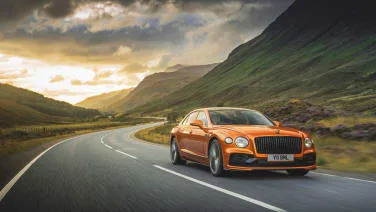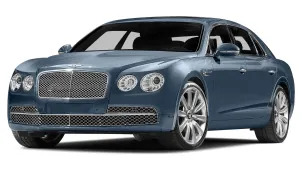2015 Bentley Flying Spur
Despite Bentley's reputation as a holier-than-thou, ultra-luxury brand, at the end of the day, the Big B is still a business. As such, ongoing trends like powertrain downsizing and model range expansion are more prevalent at Bentley than ever. Just look at the Continental range – what started as the GT W12 has expanded into the GTC W12, GT V8, GT V8 S, GTC V8, GTC V8 S, GT Speed and GTC Speed. Talk about "have it your way." But there's good reason for that. So many of these vehicles, despite their hand-crafted, bespoke nature, are all – gasp! – plug-and-play exercises that allow Bentley to appeal to the broadest range of upper-lux buyers, while keeping development costs relatively low. It's a move that's indeed worked, the company managing to post healthy sales increases year after year. And that's only going to get better, following the launch of the Flying Spur sedan last year, not to mention the upcoming, highly anticipated SUV that's in the works. As Kevin Rose, Bentley's member of the board for sales, marketing and aftersales told me recently, "The best years are yet to come." To further expand an already growing range, I recently hopped a plane to London to experience the second member of the Flying Spur family – the V8. This less-powerful Spur offers better fuel efficiency and a lower staring price, while not compromising any of the brand's core values of luxury and refinement above all. But to paraphrase what executive editor Chris Paukert said when he drove the Conti GT V8 in 2012, this is indeed The Thinking Man's Flying Spur. Here, less really is more. Driving Notes What makes this Flying Spur different from the ones before it is beneath the bonnet: a twin-turbocharged, 4.0-liter V8, seen elsewhere in the greater Volkswagen Group portfolio under the hood of the Audi S8. In the Spur, this robust engine puts out 500 horsepower and 488 pound-feet of torque. Note that those figures represent decreases of 116 hp and 102 lb-ft versus the 12-cylinder model that senior editor Seyth Miersma drove in China last year. On the surface, that seems like a huge loss. But hold on – run the two cars side by side, and the V8 is only half a second slower to 60 miles per hour (4.9 seconds, here), thanks in part to a 110-pound weight savings. What's more, despite the Flying Spur's quest of first and foremost being quiet and shielding you from the outside world, the V8 sounds a whole lot better, with a revvy, throaty quality, much like what you hear in the Audi. There's really nothing in this world that can quite compete with the pavement-warping thrust of the W12, but for what I imagine will be 95 percent of the Flying Spur's driving scenarios, the V8 is more than adequate in terms of power. The eight-speed automatic transmission does a fine job of managing things, as well – you'll never notice it's there, unless you …
Full Review
Despite Bentley's reputation as a holier-than-thou, ultra-luxury brand, at the end of the day, the Big B is still a business. As such, ongoing trends like powertrain downsizing and model range expansion are more prevalent at Bentley than ever. Just look at the Continental range – what started as the GT W12 has expanded into the GTC W12, GT V8, GT V8 S, GTC V8, GTC V8 S, GT Speed and GTC Speed. Talk about "have it your way." But there's good reason for that. So many of these vehicles, despite their hand-crafted, bespoke nature, are all – gasp! – plug-and-play exercises that allow Bentley to appeal to the broadest range of upper-lux buyers, while keeping development costs relatively low. It's a move that's indeed worked, the company managing to post healthy sales increases year after year. And that's only going to get better, following the launch of the Flying Spur sedan last year, not to mention the upcoming, highly anticipated SUV that's in the works. As Kevin Rose, Bentley's member of the board for sales, marketing and aftersales told me recently, "The best years are yet to come." To further expand an already growing range, I recently hopped a plane to London to experience the second member of the Flying Spur family – the V8. This less-powerful Spur offers better fuel efficiency and a lower staring price, while not compromising any of the brand's core values of luxury and refinement above all. But to paraphrase what executive editor Chris Paukert said when he drove the Conti GT V8 in 2012, this is indeed The Thinking Man's Flying Spur. Here, less really is more. Driving Notes What makes this Flying Spur different from the ones before it is beneath the bonnet: a twin-turbocharged, 4.0-liter V8, seen elsewhere in the greater Volkswagen Group portfolio under the hood of the Audi S8. In the Spur, this robust engine puts out 500 horsepower and 488 pound-feet of torque. Note that those figures represent decreases of 116 hp and 102 lb-ft versus the 12-cylinder model that senior editor Seyth Miersma drove in China last year. On the surface, that seems like a huge loss. But hold on – run the two cars side by side, and the V8 is only half a second slower to 60 miles per hour (4.9 seconds, here), thanks in part to a 110-pound weight savings. What's more, despite the Flying Spur's quest of first and foremost being quiet and shielding you from the outside world, the V8 sounds a whole lot better, with a revvy, throaty quality, much like what you hear in the Audi. There's really nothing in this world that can quite compete with the pavement-warping thrust of the W12, but for what I imagine will be 95 percent of the Flying Spur's driving scenarios, the V8 is more than adequate in terms of power. The eight-speed automatic transmission does a fine job of managing things, as well – you'll never notice it's there, unless you …
Hide Full Review
Hide Full Review
Retail Price
$201,000 - $222,300
MSRP / Window Sticker Price
| Engine | 4.0L V-8, 6.0L W-12 |
| MPG | Up to 14 city / 24 highway |
| Seating | 5 Passengers |
| Transmission | 8-spd auto w/OD |
| Power | 500 - 616 hp |
| Drivetrain | all wheel |
| Curb Weight | 5,341 - 5,451 lbs |
Smart Buy Program is powered by 






